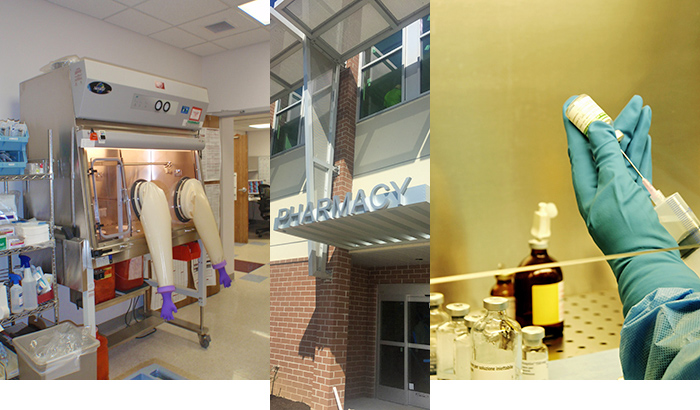USP 800 - EVERYTHING You Need to Know
Designing for Staff Safety in Healthcare Environments

Do you know how many healthcare industry employees are exposed to hazardous drugs in the workplace each year? According to the CDC, there are currently around 8 million healthcare workers in the US exposed to hazardous drugs including pharmacy and nursing personnel, physicians, operating room personnel, environmental service workers, workers in research laboratories, veterinary care workers and shipping/ receiving personnel. Depending on the severity of the exposure and toxicity, both long-term and short-term health effects, such as cancer, organ destruction and infertility, can result from these hazardous drugs.
To minimize this health risk, The United State Pharmacopeia (USP) has unveiled USP 800 “Hazardous Drugs – Handling in Healthcare Settings”. Healthcare facilities are executing modifications to meet USP 800 compliance regulations by the December 1, 2019 deadline. As healthcare designers, we need to design spaces and apply effective engineering processes to ensure that no healthcare personnel are exposed to hazardous drugs in workplace environment. It is important to understand the reason behind and implementation of the new USP 800 compliance standards to help pharmacies alter practices for medication control, compounding, dispensing and decontamination.
Why USP 800?
First and foremost, USP 800 is not a replacement but rather an addition to compounding standards that are already in place. USP 797 and USP 795 primarily pertain to the outcomes of patients by producing compounds of “acceptable strength, quality, and purity, and conditions to prevent contamination”. The focus has now switched to encompass the handling of hazardous drugs by “promoting patient safety, worker safety and environmental protection”. By keeping hospital staff safe you are in turn keeping patients safe.
Most sterile and nonsterile compounding labs have always been positive pressure environments. Recently, pharmacies have been testing wipe/swab samples in positive pressure labs in addition to common areas inside the pharmacy such as employee break rooms where non-lab staff eat and interact with patients. Wipe/swab sample testing resulted in positive hazardous drug contamination in both the lab and common areas. Industry thinking has always been that only healthcare environments handling highly contagious and infectious disease pathogens require negative pressure where no airflow can exit the room and contaminate nearby spaces. This thinking must be revised because microscopic particles of hazardous drugs are becoming airborne and being transferred to other rooms due to differences in pressure and air exchange.
All in all, the millions of healthcare industry staff members that are being exposed to hazardous drugs in the workplace needs to be mitigated. USP 800 is setting a standard that no amount of hazardous drug exposure is tolerable.
USP 800 Compliance Additions Quick Guide
- Any hazardous drugs used on the current NIOSH list must be documented and reviewed at least once every 12 months.
- Designate a pharmaceutical leader to be responsible for the management and implementation of USP 800 compliance and other applicable laws.
- Hazardous drug handling areas are to be notably segregated, made visible with signage, located away from break rooms and accessed by authorized personnel only.
- The followings areas must be individually designated (to minimize risk of exposure, certain areas require neutral/normal pressure or negative pressure comparative to the surrounding area):
- Receipt and unpacking,
- Hazardous drug storage,
- Compounding of non-sterile hazardous drugs and
- Compounding of sterile hazardous drugs.
- Environmental surface contamination wipe/swab testing is required at least once every 6 months.
- Personal protective equipment is required to be worn during the handling of hazardous drugs in receipt; storage; transport; compounding (sterile and non-sterile); administration; deactivation/decontamination, cleaning and disinfecting; spill control and waste disposal.
- Policies and procedures must be established to ensure staff safety when handling hazardous drugs.
- Depending on personnel job functions, training must occur before each employee handles hazardous drugs.
- Standard operating procedures must be established to receive hazardous drugs from suppliers. Suppliers must place hazardous drugs in impervious plastic for internal transfer, hazardous drug identification and hospital staff safety.
- Standard operating procedures must be established for labeling, packaging, transport and disposal of hazardous drugs. These procedures will detail prevention to exposure or spill, personnel exposure response protocol and spill kit instruction.
- Unless required by the manufacturer or if visually necessary, hazardous drugs that do not need manipulated, besides for dosage repackaging or counting purposes, can be prepared for dispensing.
- Administration of hazardous drugs should be done using the correct approach and with protective medical devices.
- Deactivation, decontamination and cleansing of all areas where hazardous drugs were handled must be carried out. The same goes for all reclaimable equipment and devices.
- Appropriate training in spill management must be achieved by all employees who are required to clean up spills of hazardous drugs. Personal protective equipment and NIOSH-certified respirators must be worn.
- Standard operating procedures pertaining to the way hazardous drugs are maintained and used throughout the facility must be carried out and reviewed at least once every 12 months by the designated pharmaceutical leader.
- As part of the comprehensive exposure control program associated with engineering controls, safe work procedures and the use of personal protective equipment, medical surveillance must be carried out.
Each facility should be evaluated exclusively on individual needs to produce the most efficient and cost-effective solution in relation to USP 800 compliance standards. Design modifications, which can be assessed by a healthcare design professional, will differ according to the types of hazardous drugs that are handled and existing conditions.